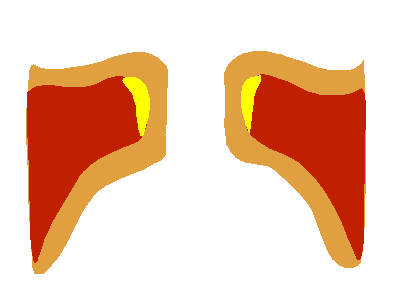This site is under construction! Stuff be missing, beware! Contribute!
If you have additions, corrections or concerns, open an issue or contact a maintainer.
Voice Map is released! See here for a giant map of (almost) all voice characteristics and pedagogy!Table of contents
Vocal Mechanisms
A vocal mechanism or register is a distinct configuration of vocal fold interaction. Which, is a complicated way of saying…
- vocal mechanisms are distinct ways the folds interact
- they describe how the vocal folds vibrate
- phonation is always within one of these mechanisms
- you can pass between mechanisms without a break with training

M0
fry
strohbass
pulse
M0 or vocal fry is at the bottom of your vocal range. Try going to your lowest note, then relax a little and go lower. The rough sound similar to an idling motorcycle engine is from M0. This is when the folds are slack and the whole fold vibrates.
- slack folds
- whole fold vibrates
- below your lowest M1 note
M1
normal speech
modal
chest voice
M1 is your normal speaking register.
- where most people speak the majority of the time
- most of the vocal folds vibrates

M2
falsetto
mix
head voice
M2 is a usually hollow, very high pitch register.
- sometimes has a gap between folds / lack of closure
- very high pitch
- the TA muscles deactivate somewhat
- mostly just mucosa of the folds vibrates

M3
whistle
flageolet
flute register
There are different theories and types of M3, but the main one is with mostly complete closure and a lot of tension, such that only a part of the folds vibrates.
- mostly only a small part of the folds vibrates and only the mucosa
- usually starts at 1000hz and can go as high as 5000hz or more.
This type of M3 is called stop closure whistle by Antonio Di Corcia and Franco Fussi’s paper↗ which puts forward the following findings:
FLW - Female Laryngeal Whistle
- “very thin, stiff and tightly stretched vocal folds”
- “Often, no contact between the folds during phonation was noted”
SCW – Stop Closure Whistle
- “the whistle sound depends on a tiny orifice at the anterior third of the folds”
- caused by high adduction
- “HSDI observation showed a total absence of vibration (normal periodic vibration) in any components of the vibrating system caused by the stop_closure phenomenon”
IW - Ingressive Whistle
- “high activity of the adductor muscles”
- “absence of vibrating parts during ingressive phonation”
Scream in M3
- “[…]very stretched, thin and stiff vocal folds and an high constriction of the false vocal folds”
- “[…]very further reduction of the mucosal wave vibration, very restricted to the edge of the fold”
The No Separation Hypothesis
This is a hypothesis that the difference between mechanisms is not a vibratory pattern that is distinct and separated, but instead a grouping of features of voice that coincide with that resulting vibratory pattern. For example, M2 might have lower IA closure, leading to incomplete vibration of the folds and lower closed quotient (CQ), and the bifurcation event (break) could be explained as being caused by the imbalance of vibration frequency and CQ, with the easiest solution to that imbalance being the loss of IA closure. M3 is simply very low pressure and high closure, and M0 is when the vibration cannot happen slow enough, either due to not enough CQ to allow for a frequency that is so low / slow, or closure causing speed quotient (SQ) to take too much of the vibratory cycle and therefore lead to the same result. This hypothesis fits the anecdotal and experimental observation of many people, but it is not known if these are the physical factors or if the relationship is coincidental.
The lack of a bifurcation event in some (especially cis female) voices could be explained by either a lack of ability to increase CQ to imbalance causing levels, or that the pressure is too low to cause that CQ; in other words the voice is too light to break.